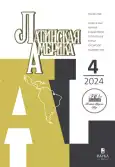State policy and the level of food security in Brazil. From successful eradication of hunger to a food crisis
- Authors: Potapova A.A.1
-
Affiliations:
- RANEPA
- Issue: No 4 (2024)
- Pages: 57-73
- Section: Social problems
- URL: https://journals.rcsi.science/0044-748X/article/view/256373
- DOI: https://doi.org/10.31857/S0044748X24040047
- ID: 256373
Cite item
Full Text
Abstract
Keywords
About the authors
Alexandra A. Potapova
RANEPA
Email: potapova-aa@ranepa.ru
ORCID iD: 0000-0001-6071-9787
Candidate of geographic sciences, researcher, Center of Agro-food policy Vernadsky pr-t., 84, 119571 Moscow, Russian Federation
References
- FAO, IFAD, PAHO, UNICEF and WFP. Regional Overview of Food Security and Nutrition – Latin America and the Caribbean 2022: towards improving affordability of healthy diets. Santiago, 2023, 156 р.
- Davis O, Geiger B.B. Did food insecurity rise across Europe after the 2008 crisis? An analysis across welfare regimes. Social Policy & Society. Cambridge, 2017. N 16 (3). рр. 43-60.
- Millennium Development Goals: the region has achieved the hunger target. Panorama 2014 of Food and Nutritional Security in Latin America and the Caribbean. Santiago, 2014, 28 p.
- Sousa L.R., Segall-Corrêa A-M., Ville A.S., Melgar-Quiñonez H. Food security status in times of financial and political crisis in Brazil. Available at: https://www.scielo.br/j/csp/a/WcpYtB8TjyLyKgLdmDLrtXB/# (accessed 24.05.2023).
- Paula L.F., Pires M. Crise e perspectivas para a economia brasileira. Estudos Avançados. São Paulo, 2017. N 31. рр.25-44.
- Grebmer K., Bernstein J., Wiemers M., Acheampong K., Hanano A., Higgins B., Chéilleachair R. N., Foley C., Gitter S., Ekstrom K. and et al. Indice Global da Fome: Uma Década Até “Fome Zero”. Dublin, Welt Hunger Hilfe, 2020, 75 p.
- Jones A.D., Ngure F.M., Pelto G., Young S.L. What are we assessing when we measure food security? A compendium and review of current metrics. Advances in Nutrition. Philadelphia, 2013, N 4(5), рр. 481-505
- Coleman-Jensen A., Rabbitt M.P., Gregory C.A., Singh A. Household food security in the United States in 2021. Available at: https://www.ers.usda.gov/webdocs/publications/104656/err-309.pdf?v=8162.5 (accessed 12.08.2023).
- The Food Insecurity Experience Scale, Voices of the Hungry. Available at: https://www.fao.org/in-action/voices-of-the-hungry/fies/en/ (accessed 08.06.2023).
- Segall-Corrêa A.M., Marin-León L., Melgar-Quiñonez H., Pérez-Escamilla R. Refinement of the Brazilian Household Food Insecurity Measurement Scale: recommendation for a 14-item EBIA. Revista de Nutrição. São Paulo, 2014, N 27 (2), рр. 241–251.
- Pesquisa de Orçamentos Familiares 2017–2018: Análise da Segurança Alimentar no Brasil. Instituto Brasileiro de Geografia e Estatística. Available at: https://www.ibge.gov.br/en/statistics/social/population/25610-pof-2017-2018-pof-en.html (accessed 29.05.2023).
- Inquérito Nacional sobre Insegurança Alimentar no Contexto da Pandemia da COVID-19 no Brasil. II VIGISAN: Rede Brasileira de Pesquisa em Soberania e Segurança Alimentar. São Paulo, SP: Fundação Friedrich Ebert, Rede PENSSAN, 2022, 112 p.
- Грациану да Силва Ж., Гросси Каю М.Э., Франча Г. Программа нулевой голод: опыт Бразилии. Бразилиа, Министерство сельского развития Бразилии, 2013, 370 с.
- Palmeira P.A., Bem-Lignani J., Maresi V.A., Mattos R.A., Interlenghi G.S., Salles-Costa R. Temporal changes in the association between food insecurity and socioeconomic status in two population-based surveys in Rio de Janeiro, Brazil. Social Indicators Research. Berlin-Heidelberg, 2019, N44(3), рр.1349-1365.
- Brasil, Presidência da República. Casa Civil, Subchefia para assuntos Jurídicos. (2006). Lei n° 11.346, de 15 de setembro de 2006. Cria o Sistema Nacional de Segurança Alimentar e Nutricional – SISAN com vistas em assegurar o direito humano à alimentação adequada e dá outras providências. Diário Oficial da União, 2006, set 18; seção1: 1-2.
- Brasil, Presidência da República. Decree No. 7,272. (25 Aug,2010). Available at: https://www.planalto.gov.br/ccivil_03/_ato2007-2010/2010/decreto/d7272.htm (accessed 17.05.2023).
- Souza, L.E., Barros, R.D., Barreto, M.L., Katikireddi, S.V., Hone, T.V., Sousa, R.P., Leyland, A., Rasella, D., Millett, C.J., Pescarini, J. The potential impact of austerity on attainment of the sustainable development goals in Brazil. Available at: https://pubmed.ncbi.nlm.nih.gov/31565412/ (accessed 14.07.2023).
- Santarelli, M., David, G., Burity, V., Rocha, N.C. Informe Dhana 2019: autoritarismo, negação de direitos e fome. Brasília, FIAN Brasil, 2019, 102 p.
- Recine, E., Fagundes, A., Silva, B.L., Garcia, J.S., Ribeiro, R.C.L., Gabriel, C.G. Reflections on the extinction of the National Council for Food and Nutrition Security and the confrontation of Covid-19 in Brazil. Available at: https://www.scielo.br/j/rn/a/sNB5F8yBvGsDNDQHYmKK6qw/?lang=en (accessed 14.07.2023).
- Costa R., Ferreira A.A., Araujo de Mattos R., Reichenheim M., Pérez-Escamilla R., Bem-Lignani J., Segall-Corrêa A-M. National Trends and Disparities in Severe Food Insecurity in Brazil between 2004 and 2018. Current Developments in Nutrition. Oxford, 2022, vol. 6, is. 4, pр. 1-11.
- Silva S. A. Regional Inequalities in Brazil: divergent readings on their origin and public policy design. Available at: https://journals.openedition.org/echogeo/15060?lang=en (accessed 20.07.2023).
- Alves B.T, Alves de Olinda R., Figueroa P.D. Insegurança alimentar no Brasil Segundo diferentes cenários sociodemográficos. Ciência & Saúde Coletiva. Rio de Janeiro. 2017, N 22, pp. 637-651.
- Chancel L, Piketty T, Saez E, Zucman G, editors. World inequality report 2022. Available at: https://wir2022.wid.world/www-site/uploads/2021/12/Summary_WorldInequalityReport2022_English.pdf (accessed 24.07.2023).
- Sabourin E., Craviotti C., Milhorance С. The Dismantling of Family Farming Policies in Brazil and Argentina. Available at: https://journals.openedition.org/irpp/799 (accessed 03.08.2023).
- LOAS/BPC: Como ter acesso com renda maior de ¼ do salário mínimo por pessoa dafamília? Available at: https://tenorioadvogados.com/loas-bpc-como-ter-acesso-com-renda-maiorde-%C2%BC-do-salario-minimo-por-pessoa-dafamilia/#:~:text=No%20ano%20de%202022%20o, a%20R%24%20303%2C00.&text=Por%20exemplo%2C%20se%20uma%20fam%C3%ADlia,de%20R%24%20400%2C00 (accessed 29.06.2023).
- Average price of a basic food basket in selected Brazilian cities in October 2023. Available at: https://www.statista.com/statistics/1382282/average-price-basic-food-basket-brazil/(accessed 15.01.2024).
- Bolsa Familia. Programas Sociais. CAIXA. Available at: https://www.caixa.gov.br/programas-sociais/bolsa-familia/Paginas/default.aspx (accessed 24.07.2023).
- Programa Restaurante Popular. Ministério do Esporte. Available at:https://www.gov.br/cidadania/pt-br/acesso-a-informacao/carta-de-servicos/ desenvolvimentosocial/inclusao-social-e-produtiva-rural/programa-restaurante-popular (accessed 29.07.2023).
Supplementary files








